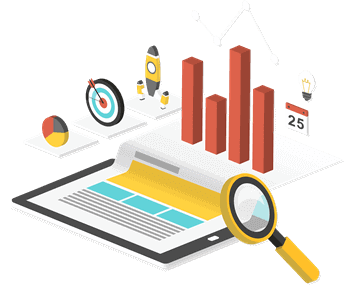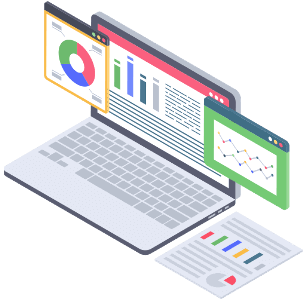 In data proliferation, the art of extracting meaningful insights from statistical data has evolved into a vital skill across various domains. From scientific research and business strategies to policy formulation, the ability to decipher the stories hidden within the numbers can be a game-changer. However, navigating the complex landscape of statistical analysis requires more than just a cursory understanding; it demands expertise and precision that often goes beyond the grasp of the average individual. The significance of accurate interpretation and actionable conclusions cannot be overstated. As such, the prospect of enlisting the services of our proficient data statistician holds immense promise. The process of analyzing data involves more than just plugging numbers into software and generating graphs. It requires a meticulous approach, encompassing data preparation, hypothesis testing, model selection, and result interpretation. Statistics, in the hands of an expert, is more than a tool; it's a language that tells a compelling narrative. There are various advantages that come with seeking professional assistance for your statistical analysis endeavors. From unraveling complex methodologies to distilling intricate findings into understandable insights, an expert statistician brings a multifaceted skill set that elevates your data analysis from a mechanical task to an intellectually rewarding exploration. Whether you're an academic researcher, a business executive, or an aspiring data enthusiast, understanding the benefits of collaborating with a statistical expert can pave the way for informed decisions and a deeper comprehension of the information hidden within your data.
In data proliferation, the art of extracting meaningful insights from statistical data has evolved into a vital skill across various domains. From scientific research and business strategies to policy formulation, the ability to decipher the stories hidden within the numbers can be a game-changer. However, navigating the complex landscape of statistical analysis requires more than just a cursory understanding; it demands expertise and precision that often goes beyond the grasp of the average individual. The significance of accurate interpretation and actionable conclusions cannot be overstated. As such, the prospect of enlisting the services of our proficient data statistician holds immense promise. The process of analyzing data involves more than just plugging numbers into software and generating graphs. It requires a meticulous approach, encompassing data preparation, hypothesis testing, model selection, and result interpretation. Statistics, in the hands of an expert, is more than a tool; it's a language that tells a compelling narrative. There are various advantages that come with seeking professional assistance for your statistical analysis endeavors. From unraveling complex methodologies to distilling intricate findings into understandable insights, an expert statistician brings a multifaceted skill set that elevates your data analysis from a mechanical task to an intellectually rewarding exploration. Whether you're an academic researcher, a business executive, or an aspiring data enthusiast, understanding the benefits of collaborating with a statistical expert can pave the way for informed decisions and a deeper comprehension of the information hidden within your data.
What you get when an expert analyzes your statistical data;
- Comprehensive Data Examination: Our statisticians don't merely run a few tests and generate charts; instead, they meticulously examine the entire dataset, identify potential outliers, assess data quality, and ensure that the dataset is suitable for analysis. This thorough examination lays the foundation for reliable results.
- Customized Methodology Selection: Selecting the right statistical methods is paramount for obtaining meaningful insights. Our experts evaluate your research objectives, the nature of your data, and the specific hypotheses you want to test. Based on this assessment, they choose the most appropriate methodologies, ensuring that your analysis is tailored to your research questions.
- Accurate Interpretation: Interpreting statistical results can be challenging, as it requires a deep understanding of the methods used and the context of the data. Our experts go beyond simply reporting numbers; they provide insightful interpretations that link the findings back to your research goals which ensure that you gain a clear understanding of the implications of the results.
- Robust Data Validation and Reliability: Experts employ rigorous validation techniques to confirm the accuracy of the analysis. When you ask for our help with analyzing statistical data, we assess the reliability of the data sources, methodologies, and assumptions made, providing you with results you can confidently rely on.
- In-Depth Insights: We don't just crunch numbers, we generate in-depth insights that go beyond the surface-level findings by helping you uncover hidden patterns, trends, and correlations within the data, enabling you to make informed decisions based on a deeper understanding of your research area.
- Clear Presentation of Results: Our expert analysts not only assist with analysis but also help in presenting results effectively. They assist in creating charts, graphs, and tables that clearly communicate the findings to your audience, whether it's your academic committee, business stakeholders, or the general public.
In data-driven decision-making, the expertise of our statisticians holds paramount importance. Their ability to unravel complex datasets, select tailored methodologies, and provide nuanced interpretations elevates the quality of analysis significantly. Collaborating with our experts not only ensures accurate results but fosters an environment of learning, refining research designs, and honing statistical skills. The collaboration extends beyond data crunching, offering comprehensive insights that guide decisions and presentations. So, whether in academia or the corporate landscape, harnessing the proficiency of our statistical experts is a strategic step toward deriving meaningful conclusions and steering projects toward success.
Research Statistical Data Analysis – You Can Rely on Us for Help
 The ability to transform raw data into actionable insights fuels advancements across diverse fields, from academia to business. At Thesis-Dissertation Writing Service, we recognize the pivotal role that accurate statistical analysis plays in shaping outcomes and we are committed to guiding you through the intricacies of this analytical journey ensuring that you can navigate the complexities with confidence. Get to know the strategies that seasoned experts employ to refine their analysis techniques, from structured data collection and appropriate test selection to data preprocessing. By following these strategies, you can elevate your analytical prowess and bolster the credibility of your findings. While mastering effective techniques is paramount, it's equally vital to be aware of the common errors that can undermine the integrity of your analysis. Let us help you explore these pitfalls, highlighting the significance of adhering to assumptions, curbing sampling biases, and avoiding data leakage. Through a comprehensive understanding of these pitfalls, you can safeguard your analysis from avoidable errors. The importance of data visualization cannot be overstated. Our article underscores the value of clear and insightful data visualization techniques. These visuals not only enhance your own comprehension of the data but also facilitate impactful communication to varied audiences, empowering decision-makers to act on your findings. We stand as your ally, ready to equip you with the tools and knowledge needed to master the art of data analysis. Our expertise, dedication, and commitment are all set to help you succeed.
The ability to transform raw data into actionable insights fuels advancements across diverse fields, from academia to business. At Thesis-Dissertation Writing Service, we recognize the pivotal role that accurate statistical analysis plays in shaping outcomes and we are committed to guiding you through the intricacies of this analytical journey ensuring that you can navigate the complexities with confidence. Get to know the strategies that seasoned experts employ to refine their analysis techniques, from structured data collection and appropriate test selection to data preprocessing. By following these strategies, you can elevate your analytical prowess and bolster the credibility of your findings. While mastering effective techniques is paramount, it's equally vital to be aware of the common errors that can undermine the integrity of your analysis. Let us help you explore these pitfalls, highlighting the significance of adhering to assumptions, curbing sampling biases, and avoiding data leakage. Through a comprehensive understanding of these pitfalls, you can safeguard your analysis from avoidable errors. The importance of data visualization cannot be overstated. Our article underscores the value of clear and insightful data visualization techniques. These visuals not only enhance your own comprehension of the data but also facilitate impactful communication to varied audiences, empowering decision-makers to act on your findings. We stand as your ally, ready to equip you with the tools and knowledge needed to master the art of data analysis. Our expertise, dedication, and commitment are all set to help you succeed.
What strategies do experts use to perfect the analysis of statistical data?
Mastering the data analysis craft requires a systematic approach. Our experts employ a range of strategies to ensure the accuracy and reliability of the findings.
- Structured Data Collection: The foundation of a robust analysis is built upon accurate data collection. Our experts meticulously design their data collection methods, ensuring that the sample size is representative and that the variables under consideration are clearly defined.
- Choosing Appropriate Statistical Tests: The choice depends on the type of data (categorical or continuous), the research objectives, and the underlying assumptions of the data.
- Preprocessing and Cleaning: Raw data often contain errors, outliers, and inconsistencies which is why we invest time in preprocessing and cleaning the data to eliminate these anomalies, ensuring that the subsequent analysis is based on reliable information.
- Exploratory Data Analysis: Before diving into complex statistical tests, experts conduct EDA to gain insights into the data's underlying patterns, relationships, and trends. ThrouThis step helps identify potential areas of interest for further study.
- Multivariate Analysis: Many real-world phenomena are influenced by multiple variables. Our experts employ multivariate analysis techniques to examine how these variables interact and contribute to the observed outcomes.
- Cross-Validation: In predictive modeling, experts use cross-validation techniques to assess the model's performance on unseen data to prevent overfitting, where the model performs well on the training data but fails to generalize to new data.
What errors and mistakes should you avoid in the process of data analysis?
While there are various strategies to enhance the quality of research statistical data analysis, there are also common errors and mistakes that should be avoided at all costs.
- Ignoring Assumptions: Statistical tests are built upon certain assumptions about the data and ignoring them can lead to inaccurate results. Experts meticulously check and meet these assumptions before applying any statistical test.
- Sampling Bias: It's crucial to ensure that the sample is representative of the population under study. Avoiding sampling bias requires careful consideration of the sampling method.
- Data Leakage: In predictive modeling, data leakage occurs when information from the future is inadvertently used to predict the past which leads to overly optimistic performance estimates. Experts take measures to prevent such leakage and ensure the model's generalizability.
- Overlooking Outliers: Ignoring outliers or handling them improperly can lead to misleading conclusions hence experts identify outliers and make informed decisions about whether to exclude, transform, or retain them.
- Ignoring Missing Data Effectively: Overlooking missing data or using improper methods to fill in the gaps can lead to biased results and distorted conclusions. There are various techniques to deal with missing data, including imputation methods, such as mean imputation, regression imputation, or using more advanced techniques like multiple imputation. The choice of method should depend on the nature of the missing data and the underlying assumptions of your analysis. Transparently reporting how missing data was handled in your analysis is also crucial for the credibility of your findings.
- Overfitting and Model Complexity: It occurs when a model captures noise and random fluctuations rather than the underlying patterns in the data which can lead to poor generalization on new, unseen data. Creating a model that is too complex or adding too many features can exacerbate this issue. It's important to strike a balance between model complexity and performance. Techniques like cross-validation can help identify if your model is overfitting, allowing you to fine-tune its parameters and ensure its ability to generalize.
Why it is advisable to have clear data visualization when analyzing data?
Clear data visualization is an essential component of the data analysis process, offering a pathway to unveiling insights that raw data alone might conceal. The significance of data visualization lies in its capacity to distill complex information into a visual format that is comprehensible, engaging, and informative. The human brain is naturally wired to process visual information with remarkable efficiency. When dealing with intricate datasets, data visualization becomes a vital tool for enhancing understanding. Through the use of charts, graphs, and plots, patterns, trends, and relationships within the data become perceptible at a glance. This rapid comprehension is particularly advantageous when time is of the essence, enabling swift decision-making. Moreover, data visualization serves as a powerful means of quality control. Outliers, anomalies, and irregularities can be swiftly identified through visual representation, allowing analysts to address them appropriately. Such prompt detection is often critical in maintaining the integrity of the analysis and the reliability of the data analysis results. When presenting findings to a diverse audience, including individuals without a deep statistical background, visualizations bridge the gap. Complex statistical concepts are translated into visual stories that resonate with various stakeholders, fostering clear communication and alignment. By graphically representing the distribution of data points, assumptions such as normality or skewness can be verified, ensuring the statistical techniques applied are appropriate and trustworthy. Similarly, data visualization empowers decision-makers in the corporate realm. Businesses thrive on data-driven insights, and visualizations provide a clear roadmap for strategic planning. Key performance indicators, market trends, and consumer behavior patterns can be effectively communicated through visual means, guiding executives in making informed choices. Data visualization's ability to simplify complexity, expedite comprehension, assist in quality control, facilitate communication, validate assumptions, and support decision-making underscores its integral role. By harnessing the power of data visualization, analysts can illuminate the path from raw data to valuable insights, ensuring that the significance of their findings is both understood and appreciated.
Mastering the process of analyzing project data is a skill that requires a combination of meticulous planning, expertise in statistical techniques, and a keen awareness of potential pitfalls. We are committed to helping you navigate the complexities of data analysis. Our experienced professionals can guide you through the strategies that experts employ to ensure the accuracy of their analyses. Moreover, we emphasize the importance of avoiding common errors that can compromise the integrity of your results. By incorporating clear data visualization techniques, we ensure that your insights are not only robust but also accessible to a wider audience. With our guidance, you can confidently embark on your research journey, knowing that you have a reliable partner to assist you in perfecting the art of project data analysis.





 We guarantee you the
We guarantee you the 